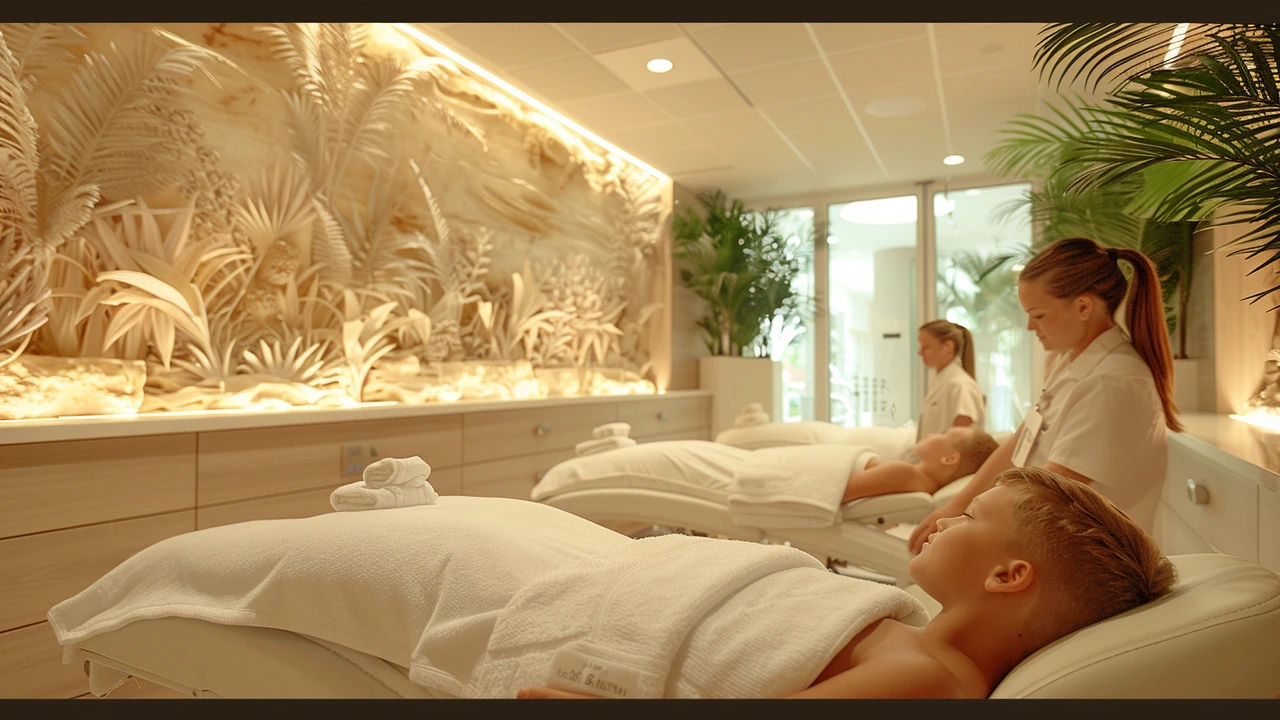
Craniosacral Therapy (CST) is a holistic treatment that’s been gaining attention for its ability to heal a variety of physical and emotional issues. Originating in the 1970s, this gentle, hands-on approach is designed to relieve pain and tension by manipulating the body's craniosacral system, which includes the membranes and fluids surrounding the brain and spinal cord.
What makes CST particularly appealing is not just its potential to relieve conditions like migraines, chronic pain, and even anxiety, but also its non-invasive nature. Practitioners use subtle manipulations, often feeling like barely detectable touches, to encourage the body’s natural healing mechanisms.
Whether you’re new to alternative medicine or simply seeking ways to enhance your well-being, Craniosacral Therapy offers promising benefits that could make a big difference in your life.
- Understanding Craniosacral Therapy
- The Science Behind CST
- Health Benefits
- Practical Tips and Considerations
Understanding Craniosacral Therapy
Craniosacral Therapy (CST) was developed in the 1970s by Dr. John Upledger, an osteopathic physician. He observed the rhythmic motion of the craniosacral system while assisting in a spinal surgery. This discovery led him to explore ways to harness this rhythm for healing purposes. CST is based on the idea that the body's craniosacral system—which encompasses the membranes and cerebrospinal fluid surrounding the brain and spinal cord—affects our overall health.
The therapy itself is gentle and non-invasive. During a session, practitioners use light touches, often no heavier than the weight of a coin, to feel for imbalances or restrictions. Through these subtle manipulations, therapists aim to release tension and improve the circulation of cerebrospinal fluid. This helps to enhance the body’s natural healing processes. What's fascinating is that these light touches can lead to significant improvements in physical conditions and emotional well-being.
People who undergo CST often report relief from chronic pain, migraines, and stress-related disorders. According to the Upledger Institute, CST has been particularly effective for conditions like fibromyalgia and post-traumatic stress disorder (PTSD). One of the aspects that makes CST so accessible is its suitability for people of all ages, from newborns to the elderly. This universal applicability is a big reason for its growing popularity.
Moreover, CST isn't just for those with specific ailments. Many individuals find it beneficial for general wellness, experiencing a sense of deep relaxation and mental clarity. A survey conducted by the American Holistic Health Association revealed that 83% of CST patients felt significant improvement in their overall mental and emotional state. This is a striking testament to the therapy's holistic benefits.
Another compelling aspect of CST is the philosophy that underpins it. The idea is that our bodies know how to heal themselves; they just need a gentle nudge in the right direction. According to Dr. Upledger, “The inherent intelligence of the body will seek its most optimum form and function if given the opportunity.” This notion resonates well with those who prefer more natural and minimally-invasive healing methods.
Training to become a CST practitioner involves rigorous education. Those interested often undertake courses through institutions like the Upledger Institute, which offers extensive training programs focusing on anatomy, physiology, and the specific techniques used in CST. Practitioners need to develop a highly sensitive touch, capable of detecting the minute imbalances within the craniosacral system. This expertise enables them to target and alleviate the root causes of a patient’s discomfort.

The Science Behind CST
The science of Craniosacral Therapy (CST) is rooted in the understanding that our bodies possess an intelligent system designed to correct imbalances and promote healing. This system, known as the craniosacral system, includes the membranes and cerebrospinal fluid protecting and nourishing the brain and spinal cord. By gently manipulating these areas, practitioners aim to support the body's natural healing processes.
The practice of CST is based on the work of Dr. John E. Upledger, an osteopathic physician who discovered that the craniosacral system has a palpable rhythmic motion. He found that this cranial rhythm could be detected and influenced to address dysfunctions of the central nervous system. Studies and case reports have shown that these gentle manipulations can have profound effects on various health conditions, ranging from headaches to emotional trauma.
When discussing the scientific basis of CST, it's essential to highlight the concept of somatoemotional release. This is the idea that emotional trauma and stress can become trapped in the body, contributing to physical symptoms and chronic pain. By facilitating the release of these tensions through CST techniques, therapists can help patients experience both physical and emotional relief. Although somatoemotional release is a relatively new area of study, preliminary research and anecdotal evidence suggest that it can be an effective component of holistic health care.
"Craniosacral Therapy is an incredibly gentle yet profound method of healing that can enhance the body's innate healing mechanisms," states the Upledger Institute International.
A study published in the Journal of Alternative and Complementary Medicine explored the effects of CST on patients with chronic pain. The results indicated significant improvements in pain levels, functional status, and quality of life. What makes this therapy particularly fascinating is that it works by addressing the root causes of imbalance rather than merely treating symptoms.
Furthermore, research has shown that CST can have a positive impact on the autonomic nervous system, which regulates many of the body's vital functions. For instance, by promoting relaxation and reducing stress, CST can help normalize blood pressure, improve digestion, and boost immune function. These systemic benefits highlight the therapy's potential to enhance overall well-being in a holistic manner.
In terms of the mechanisms at play, one school of thought posits that CST works by improving the flow of cerebrospinal fluid, which plays a crucial role in protecting and nourishing the brain and spinal cord. By freeing restrictions in the craniosacral system, therapists may help optimize this fluid circulation, thereby supporting the body’s natural healing abilities. Another hypothesis suggests that the light touch techniques used in CST activate the parasympathetic nervous system, which promotes relaxation and healing.
While the scientific community continues to explore the full range of benefits and mechanisms underlying CST, there is already a growing body of evidence supporting its effectiveness. As more research emerges, it's likely that we will gain a deeper understanding of how this therapy can be integrated into conventional medical practices to enhance patient outcomes. The non-invasive and holistic nature of CST makes it a compelling option for those seeking alternative methods for health and healing.

Health Benefits
Exploring the health benefits of Craniosacral Therapy (CST) reveals a host of compelling reasons to consider this gentle, hands-on approach. One of the most notable benefits is its effectiveness in pain relief. CST has shown promise in treating chronic headaches, migraines, neck pain, and lower back pain. The therapy assists in relieving tension in key areas of the body, facilitating the release of deep pains and tightness. A study published in the journal 'Complementary Therapies in Medicine' found that patients reported significant reductions in both pain intensity and frequency after undergoing CST sessions.
Another important benefit is its ability to enhance emotional health. People dealing with high levels of stress, anxiety, or depression might find CST beneficial. The treatment operates on the principle that emotional trauma can manifest as physical discomfort in the body. By alleviating physical tension, CST may help unlock and resolve emotional blockages, resulting in improved overall mental health. Dr. John Upledger, a key figure in the development of CST, has documented numerous cases where patients have experienced emotional breakthroughs following treatments.
Additionally, Craniosacral Therapy is lauded for its benefits in improving sleep patterns. Individuals suffering from insomnia or other sleep disorders often experience better sleep quality after CST sessions. The therapy’s focus on relaxation and stress reduction transfers into more restful sleep. A better night’s sleep can lead to enhanced mood, better concentration, and increased energy levels. To support this, many practitioners note the calming effect of CST on the nervous system, which can directly influence sleep quality.
Craniosacral Therapy can also support the body's immune system. By reducing stress and promoting deep relaxation, CST may enhance immune function. Stress is a well-documented factor that reduces immune efficiency, making the body more susceptible to illnesses. Regular CST sessions could help maintain a balanced immune response, potentially reducing the frequency of common colds and other infections.
Furthermore, this therapy is beneficial for people recovering from trauma or injury. CST can aid in the recovery process by fostering a state of balance within the body, promoting an environment conducive to healing. For instance, athletes recovering from sports injuries often turn to CST because it not only addresses physical discomfort but also supports the body’s natural healing processes. This approach has made it a favorite amongst both professionals and fitness enthusiasts.
It’s also worth noting the potential benefits for those with more specific conditions. CST has been reported to help with conditions such as fibromyalgia, temporomandibular joint disorders (TMJ), and even some forms of tinnitus. By addressing the underlying tensions and misalignments within the craniosacral system, CST offers relief where conventional treatments might fall short. Although more research is needed, initial findings and countless anecdotal reports highlight its potential.
“Craniosacral Therapy is a gentle yet powerful treatment that has helped many people find relief from debilitating conditions. It works by tapping into the body’s own healing mechanisms,” – Dr. John Upledger.
In summary, the wide range of health benefits associated with Craniosacral Therapy makes it a versatile tool for holistic health management. Whether you’re dealing with chronic pain, emotional stress, sleep issues, or a low immune system, CST may offer a gentle yet effective solution. With growing recognition from both patients and healthcare professionals, it’s a therapy worth exploring for its profound potential to improve quality of life.

Practical Tips and Considerations
Diving into Craniosacral Therapy can feel like embarking on a journey into uncharted waters. If you're considering this holistic approach, here are some practical tips and considerations to help you make the most of the experience.
Choosing the Right Therapist
Finding the right practitioner is crucial to your therapeutic experience. Ensure that you seek out a certified Craniosacral Therapist who has undergone extensive training. Look for practitioners who are associated with reputable organizations like the Upledger Institute or the Craniosacral Therapy Association.
“Working with a therapist who understands the subtle nuances of CST can make all the difference,” says Dr. John Upledger, the pioneer of Craniosacral Therapy.
Understanding the Process
Before diving into your first session, it's a good idea to have a basic understanding of what to expect. Sessions usually last between 45 minutes to an hour. Unlike traditional massage, CST involves very light touches. You will remain fully clothed, typically lying down on a comfortable table, as the therapist gently manipulates the craniosacral system.
Communicate Your Needs
Always communicate your specific needs and concerns with your therapist. Each session should be tailored to address your unique issues, whether it's chronic pain, migraines, or emotional stress. Open dialogue ensures that you and your therapist are on the same page and that the therapy can be most effective.
Be Patient
Results from Craniosacral Therapy may not be immediate. Some people experience relief after just one session, while others may require several visits. Patience and consistency are key. It's also essential to pair CST with other healthy practices such as good nutrition, regular exercise, and sufficient sleep for maximum benefits.
Self-Care Post-Session
After your session, give yourself time to relax and absorb the benefits. Some people find that drinking plenty of water helps to flush out toxins and support the body's natural healing processes. It might also be beneficial to engage in a gentle activity like yoga or meditation to further enhance the effects of the therapy.
Consider the Cost
Craniosacral Therapy can be expensive, and it is often not covered by insurance. Prices can range significantly depending on where you live and the therapist’s level of experience. Make sure to consider your budget and perhaps seek out packages or discounts that some therapists may offer for multiple sessions.
Research and Read Reviews
Doing ample research and reading reviews can provide insight into the quality of a therapist and the experiences of others. Websites like Healthline and WebMD often feature client testimonials and detailed descriptions that can help you make an informed choice.
Try Complementary Therapies
Craniosacral Therapy can be even more effective when combined with other forms of treatment. Many people find that adding practices such as acupuncture, chiropractic care, or even traditional massage enhances the overall benefits of CST. Discuss with your therapist to develop a holistic treatment plan tailored to your needs.
Embarking on Craniosacral Therapy can be a transformative experience. By taking these practical tips into account, you can ensure that you get the most out of this unique and healing therapy.




